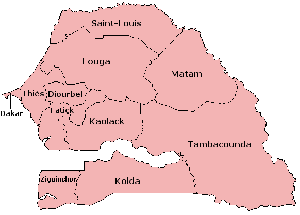A Brief Glimpse of Senegal's History
From The Peopling of New York City

| ||||||||
|---|---|---|---|---|---|---|---|---|
|
The country of Senegal spans about 76,000 square miles along the western part of Africa. To the north are Mauritana and Mali, while Guinea and Guinea-Bissau share Senegal’s southern border. The northern part of the country is mostly savanna, but the southern part, known as the “bread basket” of the country, is forested and receieves high levels of rainfall. The average temperature ranges from 63 degrees Fahrenheit to 82 degrees Fahrenheit. The capital city of Senegal is Dakar, the western-most point of the continent. Other major cities are Diourbel, Rufisque, Thies, and Saint Louis. During the 15th century the Portuguese, in search of areas to colonize, were drawn to the western part of Africa because they were looking for a harbor that would allow them access into the interior of the continent, the source of gold and other valued minerals. The Senegal River and the Gambia Estuary provided this easy entrance. This area would later be called ‘Senegal’, which people say is a mispronunciation of the Wolof word, “Sunungal” which means “dugout canoe”. After the Portuguese, the French came to the area and claimed a trading station. Later, between the 17th and 19th centuries, the French took over two islands, St. Louis and Gorée, and established the city of Dakar in 1857. Saint Louis was the first capital. It was considered a prime piece of land because of it's location at the mouth of the Senegal River. Greatly utilized as a port, St. Louis became an important business center. In 1902 Dakar was named the new capital.Gorée island holds a significant part of history in its soil: the African slave trade. Located 2.3 miles from Dakar, this island was settled by the French in 1817. It was used as a rest stop by European ships before they continued their transport of African slaves to America and the Caribbean. Later in 1929, Gorée was annexed to Dakar. Today, it is the home to schools and museums, the most famous being the Masion des Esclaves, or the House of Slaves. During January of 1959 the region became known as the Mali Federation. Shortly after, Senegal turned into a fully independent nation on April 4, 1960, while the rest of former Soudan became the Republic of Mali. The first president of Senegal was Leopold Senghor and its prime minister was Mamadou Dia. When Prime Minister Dia was arrested due to an attempted coup, Senegal constructed a constitution, which limited the power of the president. President Senghor made it a priority to promote and expand culture. He worked to foster the first World Festival of the Negro Arts. As a poet he focused much of his works on negritude and cultural mixing. He became a member of the French Academy, an organization of members that contribute to the French language, on March 29, 1984. His literary works include Nocturnes, a series of poems, and Négritude et Humanisme. In 1981 Abdou Diouf became president. During his term, relations between Senegal and other nations improved, political involvement was stimulated, and there was less government intervention in the economy. In the proceeding years Diouf’s opponent, Abdoulaye Wade, gained support among the Senegalese and became president of Senegal in the year 2000. Overall, Senegal has succeeded in retaining peaceful transitions of power and in preserving democracy. The people of Senegal belong to many different ethnic groups. Among them are Wolof, the largest ethnic group, Fulani, Serer, and Tukolor. The economy is agriculturally based, so most of the people work as farmers or fishermen. The main crops include peanuts, millet, cassava, and rice. However, industrial business is increasing in the cities. Most of these occupations are in petroleum refining, construction materials, and basic consumer goods. During the 1970’s a devastating drought hit most parts of Africa, causing a decline in the farming industry. In addition to famine the drought caused urban migration. Many relocated to industrial cities, like Dakar, in search of jobs and a means to survive. This later transformed into international migration when the Senegalese and other Africans starting moving to France, then later to the United States in the mid-1980’s. |
Sources
http://www.historyworld.net/wrldhis/PlainTextHistories.asp?historyid=ac64
http:// www.ausenegal.com/decouvrir_en/histoire.php
http://www.state.gov/r/pa/ei/bgn/2862.htm



